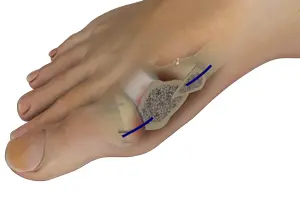What Are the Costs Involved in Bunion Surgery? A Financial Overview
What Are the Costs Involved in Bunion Surgery? A Financial Overview

Bunion surgery is a common procedure for those suffering from painful bunions, a deformity of the big toe joint that can cause significant discomfort and limit mobility. However, the decision to undergo bunion surgery is often influenced not only by the physical discomfort but also by the financial implications. Understanding the costs involved in bunion surgery can help patients make informed decisions and plan for the procedure effectively. In this blog post, we will explore the various costs associated with bunion surgery, including the factors that affect these costs, insurance considerations, and ways to manage the financial burden.
Understanding Bunion Surgery Costs
The cost of bunion surgery can vary widely depending on several factors, including the type of surgery, the surgeon’s expertise, the location of the surgery, and the type of facility where the procedure is performed. On average, the cost of bunion surgery in the United States ranges from $3,500 to $12,000. However, this estimate can fluctuate based on the specifics of each case.
- Type of Surgery: Bunion surgery can be performed using traditional open surgery or minimally invasive techniques. Minimally invasive surgery for bunions is a newer approach that typically involves smaller incisions, less tissue damage, and a faster recovery time. While minimally invasive procedures are often more expensive upfront due to the advanced technology and specialized skills required, they can lead to lower overall costs by reducing recovery time and associated expenses.
- Surgeon’s Expertise: The experience and reputation of the surgeon performing the procedure can significantly impact the cost. Highly skilled and experienced surgeons may charge higher fees, but their expertise can reduce the risk of complications and improve the overall outcome of the surgery. It’s essential to balance cost considerations with the quality of care to ensure the best possible result.
- Geographic Location: The cost of bunion surgery can also vary depending on the geographic location of the procedure. In metropolitan areas or regions with a higher cost of living, surgical fees may be higher. Conversely, patients in rural areas or regions with a lower cost of living may find more affordable options. Additionally, the availability of specialized surgical centers in certain locations can influence the overall cost.
- Type of Facility: Bunion surgery can be performed in a hospital, an outpatient surgical center, or a specialized podiatry clinic. The choice of facility can impact the cost, with hospitals generally being the most expensive option due to their comprehensive services and resources. Outpatient surgical centers and specialized clinics may offer more cost-effective options for patients who do not require extensive post-operative care.
Breakdown of Bunion Surgery Costs
To better understand the costs involved in bunion surgery, it’s helpful to break down the various components that contribute to the total expense:
- Surgeon’s Fee: The surgeon’s fee is a significant portion of the overall cost and typically ranges from $2,000 to $5,000, depending on the complexity of the surgery and the surgeon’s expertise. This fee covers the surgeon’s time, skills, and the use of specialized equipment.
- Anesthesia Fees: Anesthesia is required to ensure the patient’s comfort during the procedure. The cost of anesthesia can vary depending on whether general or local anesthesia is used. General anesthesia is more expensive and may cost between $600 and $1,500, while local anesthesia or a regional nerve block may be less costly.
- Facility Fees: The facility fee covers the cost of using the surgical facility, including the operating room, medical equipment, and support staff. This fee can range from $1,000 to $3,000, depending on the type of facility and the duration of the surgery.
- Pre-Operative and Post-Operative Care: Pre-operative consultations, diagnostic tests, and post-operative follow-up appointments are essential components of bunion surgery. These costs can add up, ranging from $500 to $1,000. Additionally, patients may need to purchase special footwear, orthotics, or mobility aids to support recovery, which can contribute to the overall expense.
- Medication Costs: Prescription medications, such as pain relievers, antibiotics, and anti-inflammatory drugs, are often required after surgery to manage pain and prevent infection. The cost of medications can vary based on the type and duration of use but typically ranges from $50 to $200.
- Physical Therapy: Physical therapy is often recommended as part of the recovery process to restore mobility and strengthen the foot. The cost of physical therapy sessions can vary depending on the frequency and duration of treatment, with a typical range of $50 to $150 per session. Depending on the patient’s recovery needs, the total cost for physical therapy can add up to several hundred dollars.
Insurance Considerations for Bunion Surgery
Insurance coverage is a critical factor in determining the out-of-pocket costs for bunion surgery. Most health insurance plans cover bunion surgery when it is deemed medically necessary, meaning that the surgery is required to relieve pain, improve mobility, or prevent further complications. However, the extent of coverage can vary based on the insurance plan and the specific details of the patient’s condition.
- Insurance Coverage: Patients should check with their insurance provider to confirm whether bunion surgery is covered under their plan. In most cases, insurance will cover a portion of the costs, including the surgeon’s fee, anesthesia, facility fees, and post-operative care. However, patients may still be responsible for co-pays, deductibles, and any costs that exceed the insurance company’s approved amounts.
- Pre-Authorization: Some insurance plans require pre-authorization before covering bunion surgery. This process involves obtaining approval from the insurance company, which may require documentation from the patient’s healthcare provider demonstrating the medical necessity of the procedure.
- Out-of-Network Costs: If the surgeon or facility is not within the patient’s insurance network, the out-of-pocket costs may be higher. Patients should verify whether their chosen provider is in-network to avoid unexpected expenses.
Managing the Financial Burden of Bunion Surgery
While the costs associated with bunion surgery can be significant, there are several strategies patients can use to manage the financial burden:
- Health Savings Accounts (HSAs) and Flexible Spending Accounts (FSAs): Patients with HSAs or FSAs can use these tax-advantaged accounts to pay for medical expenses, including bunion surgery. Contributions to these accounts are made with pre-tax dollars, which can help reduce the overall cost.
- Payment Plans: Many surgical centers and clinics offer payment plans to help patients spread out the cost of bunion surgery over time. Patients should inquire about financing options during the consultation to determine the best plan for their budget.
- Negotiating Costs: In some cases, patients may be able to negotiate the cost of surgery with their provider, particularly if they are paying out of pocket. Surgeons and facilities may offer discounts or reduced fees to accommodate patients’ financial situations.
- Medical Tourism: For patients seeking more affordable options, medical tourism—traveling to another country for surgery—may be an option. However, this approach comes with additional risks and considerations, such as ensuring the quality of care and managing post-operative follow-up.
Conclusion
Bunion surgery is a significant investment in one’s health and well-being. By understanding the various costs involved and exploring options to manage the financial burden, patients can make informed decisions and plan for a successful recovery. Whether choosing traditional surgery or a minimally invasive surgery for bunions, it’s essential to consider all financial aspects of the procedure.
For those in the Scottsdale area, seeking minimally invasive surgery for bunions in Scottsdale, AZ can offer a specialized approach that balances cost with the benefits of reduced recovery time and improved outcomes.









